Mental Health and Disability Policies: An Australian Review
VerifiedAdded on 2022/10/09
|13
|2859
|20
Report
AI Summary
This report provides a comprehensive review of mental health and disability policies in Australia. It begins with an introduction to the importance of these policies, highlighting the role of the government in establishing benchmarks for mental health and disability care. The report then delves into specific policies, including the National Mental Health Policy and various disability-related acts and schemes, outlining their historical context, objectives, and key features. It examines the roles of these policies in promoting mental health, preventing discrimination, and ensuring access to services. The overview of mental health in Australia, including the prevalence of mental health issues and the resources allocated to address them, is also included. The report further explores the roles of disability policies in fostering equal treatment and opportunities, and it assesses the impact of these policies on individuals with disabilities and their carers. The analysis covers the impact on employment, public services, and overall societal integration, concluding with a summary of the policies' effects on the lives of people with disabilities and the positive changes they have brought about.

STUDENT DETAILS
HEALTHCARE
Running Head: HEALTHCARE 0
HEALTHCARE
Running Head: HEALTHCARE 0
Paraphrase This Document
Need a fresh take? Get an instant paraphrase of this document with our AI Paraphraser
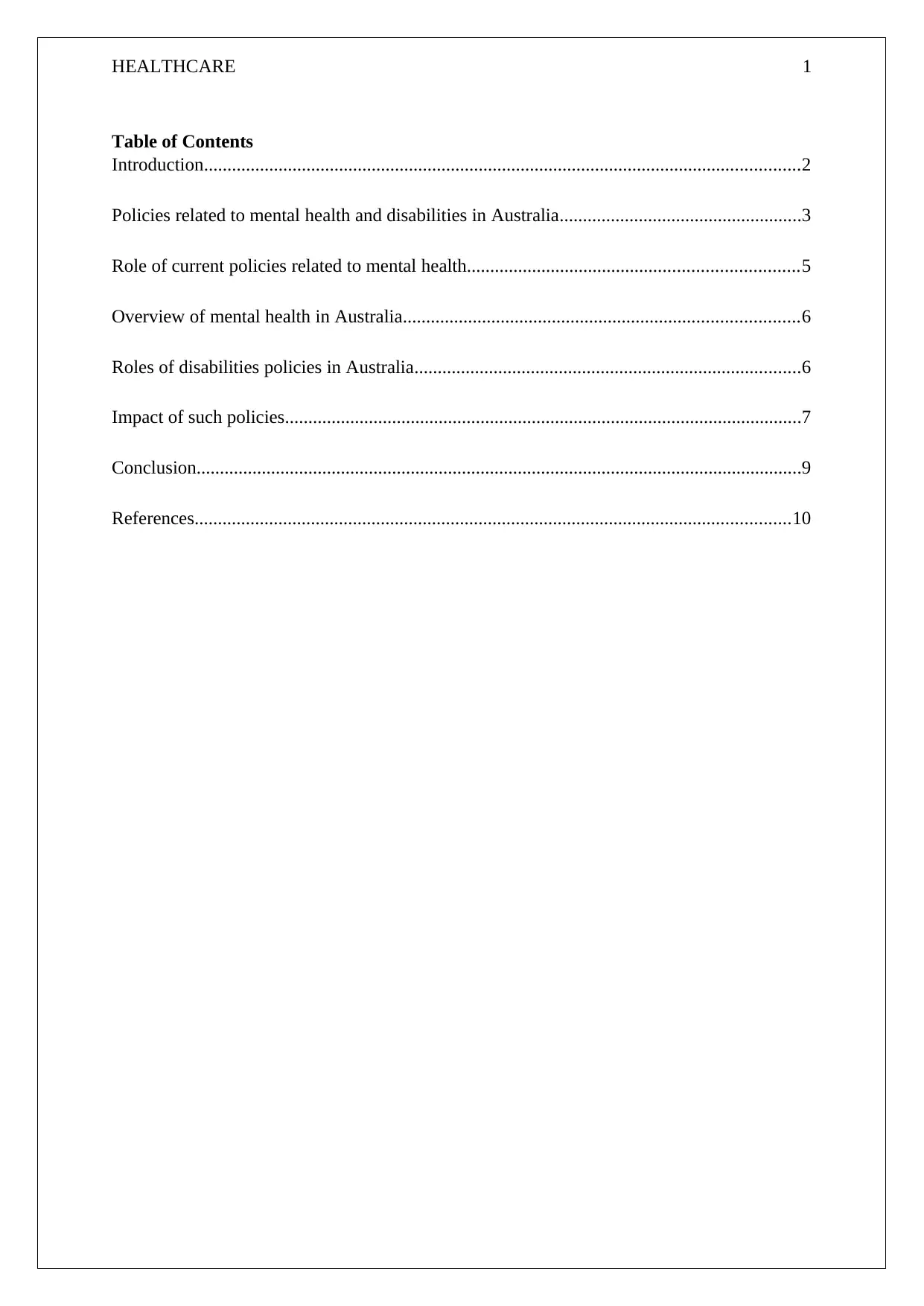
HEALTHCARE 1
Table of Contents
Introduction................................................................................................................................2
Policies related to mental health and disabilities in Australia....................................................3
Role of current policies related to mental health.......................................................................5
Overview of mental health in Australia.....................................................................................6
Roles of disabilities policies in Australia...................................................................................6
Impact of such policies...............................................................................................................7
Conclusion..................................................................................................................................9
References................................................................................................................................10
Table of Contents
Introduction................................................................................................................................2
Policies related to mental health and disabilities in Australia....................................................3
Role of current policies related to mental health.......................................................................5
Overview of mental health in Australia.....................................................................................6
Roles of disabilities policies in Australia...................................................................................6
Impact of such policies...............................................................................................................7
Conclusion..................................................................................................................................9
References................................................................................................................................10
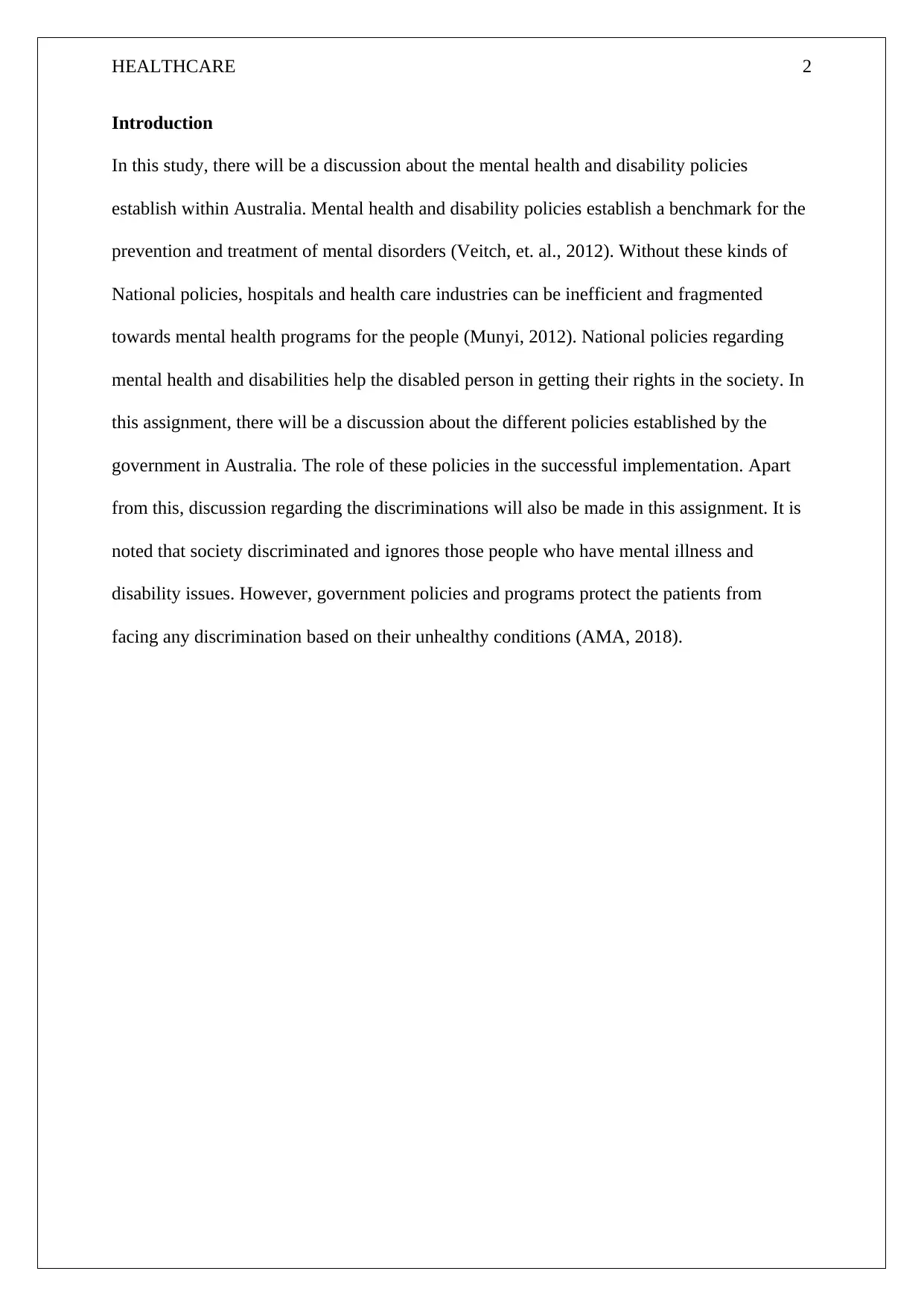
HEALTHCARE 2
Introduction
In this study, there will be a discussion about the mental health and disability policies
establish within Australia. Mental health and disability policies establish a benchmark for the
prevention and treatment of mental disorders (Veitch, et. al., 2012). Without these kinds of
National policies, hospitals and health care industries can be inefficient and fragmented
towards mental health programs for the people (Munyi, 2012). National policies regarding
mental health and disabilities help the disabled person in getting their rights in the society. In
this assignment, there will be a discussion about the different policies established by the
government in Australia. The role of these policies in the successful implementation. Apart
from this, discussion regarding the discriminations will also be made in this assignment. It is
noted that society discriminated and ignores those people who have mental illness and
disability issues. However, government policies and programs protect the patients from
facing any discrimination based on their unhealthy conditions (AMA, 2018).
Introduction
In this study, there will be a discussion about the mental health and disability policies
establish within Australia. Mental health and disability policies establish a benchmark for the
prevention and treatment of mental disorders (Veitch, et. al., 2012). Without these kinds of
National policies, hospitals and health care industries can be inefficient and fragmented
towards mental health programs for the people (Munyi, 2012). National policies regarding
mental health and disabilities help the disabled person in getting their rights in the society. In
this assignment, there will be a discussion about the different policies established by the
government in Australia. The role of these policies in the successful implementation. Apart
from this, discussion regarding the discriminations will also be made in this assignment. It is
noted that society discriminated and ignores those people who have mental illness and
disability issues. However, government policies and programs protect the patients from
facing any discrimination based on their unhealthy conditions (AMA, 2018).
⊘ This is a preview!⊘
Do you want full access?
Subscribe today to unlock all pages.

Trusted by 1+ million students worldwide
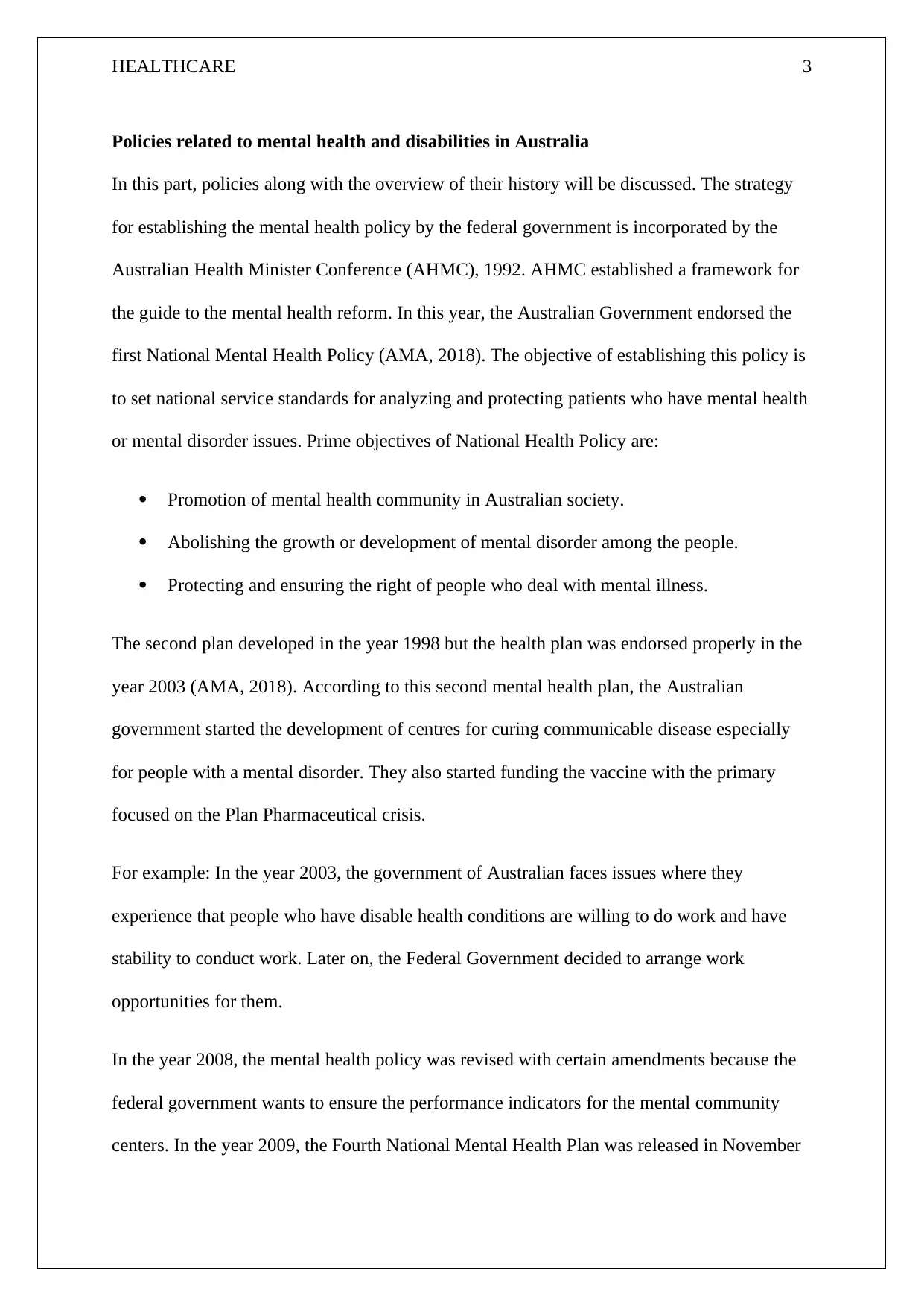
HEALTHCARE 3
Policies related to mental health and disabilities in Australia
In this part, policies along with the overview of their history will be discussed. The strategy
for establishing the mental health policy by the federal government is incorporated by the
Australian Health Minister Conference (AHMC), 1992. AHMC established a framework for
the guide to the mental health reform. In this year, the Australian Government endorsed the
first National Mental Health Policy (AMA, 2018). The objective of establishing this policy is
to set national service standards for analyzing and protecting patients who have mental health
or mental disorder issues. Prime objectives of National Health Policy are:
Promotion of mental health community in Australian society.
Abolishing the growth or development of mental disorder among the people.
Protecting and ensuring the right of people who deal with mental illness.
The second plan developed in the year 1998 but the health plan was endorsed properly in the
year 2003 (AMA, 2018). According to this second mental health plan, the Australian
government started the development of centres for curing communicable disease especially
for people with a mental disorder. They also started funding the vaccine with the primary
focused on the Plan Pharmaceutical crisis.
For example: In the year 2003, the government of Australian faces issues where they
experience that people who have disable health conditions are willing to do work and have
stability to conduct work. Later on, the Federal Government decided to arrange work
opportunities for them.
In the year 2008, the mental health policy was revised with certain amendments because the
federal government wants to ensure the performance indicators for the mental community
centers. In the year 2009, the Fourth National Mental Health Plan was released in November
Policies related to mental health and disabilities in Australia
In this part, policies along with the overview of their history will be discussed. The strategy
for establishing the mental health policy by the federal government is incorporated by the
Australian Health Minister Conference (AHMC), 1992. AHMC established a framework for
the guide to the mental health reform. In this year, the Australian Government endorsed the
first National Mental Health Policy (AMA, 2018). The objective of establishing this policy is
to set national service standards for analyzing and protecting patients who have mental health
or mental disorder issues. Prime objectives of National Health Policy are:
Promotion of mental health community in Australian society.
Abolishing the growth or development of mental disorder among the people.
Protecting and ensuring the right of people who deal with mental illness.
The second plan developed in the year 1998 but the health plan was endorsed properly in the
year 2003 (AMA, 2018). According to this second mental health plan, the Australian
government started the development of centres for curing communicable disease especially
for people with a mental disorder. They also started funding the vaccine with the primary
focused on the Plan Pharmaceutical crisis.
For example: In the year 2003, the government of Australian faces issues where they
experience that people who have disable health conditions are willing to do work and have
stability to conduct work. Later on, the Federal Government decided to arrange work
opportunities for them.
In the year 2008, the mental health policy was revised with certain amendments because the
federal government wants to ensure the performance indicators for the mental community
centers. In the year 2009, the Fourth National Mental Health Plan was released in November
Paraphrase This Document
Need a fresh take? Get an instant paraphrase of this document with our AI Paraphraser
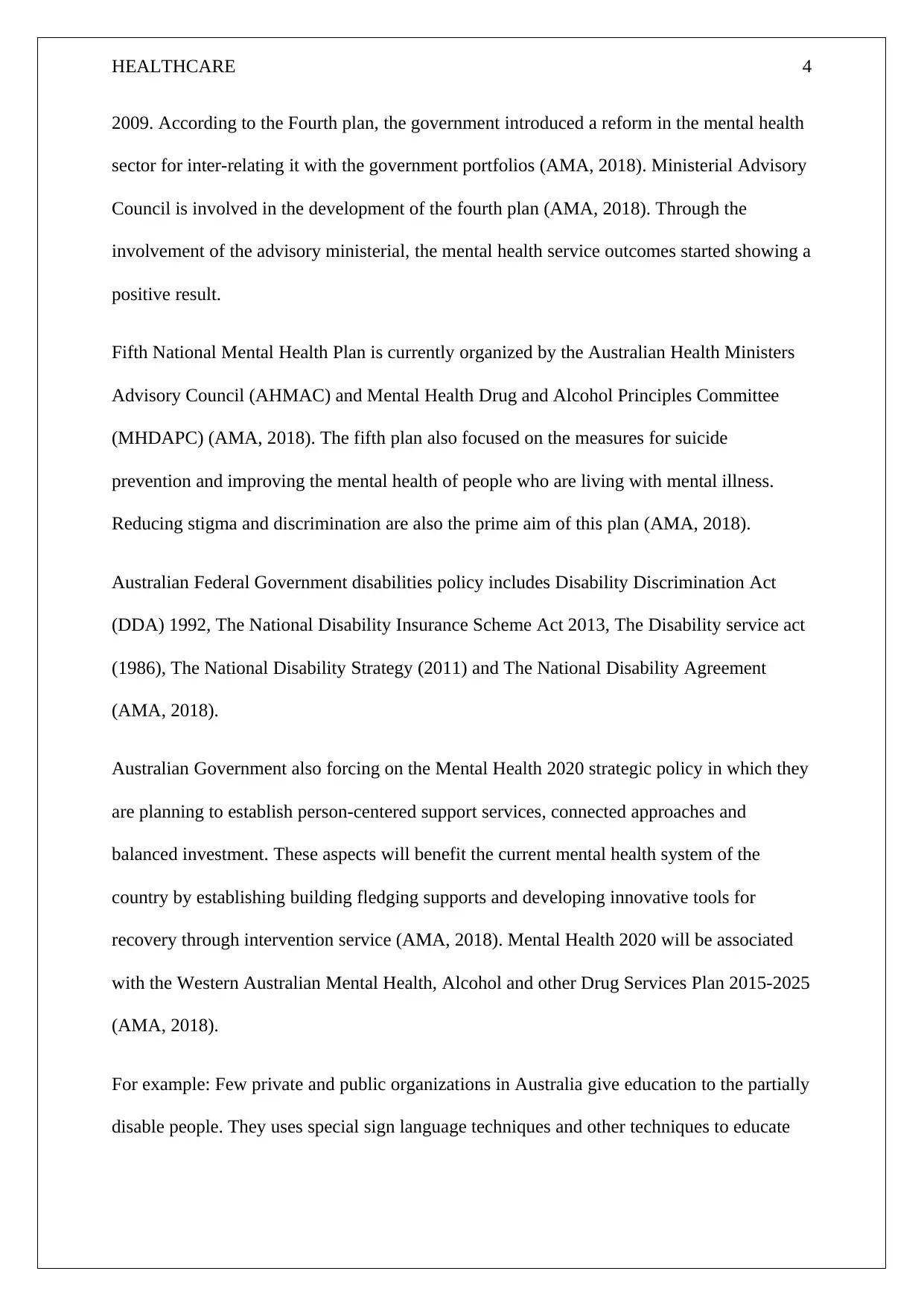
HEALTHCARE 4
2009. According to the Fourth plan, the government introduced a reform in the mental health
sector for inter-relating it with the government portfolios (AMA, 2018). Ministerial Advisory
Council is involved in the development of the fourth plan (AMA, 2018). Through the
involvement of the advisory ministerial, the mental health service outcomes started showing a
positive result.
Fifth National Mental Health Plan is currently organized by the Australian Health Ministers
Advisory Council (AHMAC) and Mental Health Drug and Alcohol Principles Committee
(MHDAPC) (AMA, 2018). The fifth plan also focused on the measures for suicide
prevention and improving the mental health of people who are living with mental illness.
Reducing stigma and discrimination are also the prime aim of this plan (AMA, 2018).
Australian Federal Government disabilities policy includes Disability Discrimination Act
(DDA) 1992, The National Disability Insurance Scheme Act 2013, The Disability service act
(1986), The National Disability Strategy (2011) and The National Disability Agreement
(AMA, 2018).
Australian Government also forcing on the Mental Health 2020 strategic policy in which they
are planning to establish person-centered support services, connected approaches and
balanced investment. These aspects will benefit the current mental health system of the
country by establishing building fledging supports and developing innovative tools for
recovery through intervention service (AMA, 2018). Mental Health 2020 will be associated
with the Western Australian Mental Health, Alcohol and other Drug Services Plan 2015-2025
(AMA, 2018).
For example: Few private and public organizations in Australia give education to the partially
disable people. They uses special sign language techniques and other techniques to educate
2009. According to the Fourth plan, the government introduced a reform in the mental health
sector for inter-relating it with the government portfolios (AMA, 2018). Ministerial Advisory
Council is involved in the development of the fourth plan (AMA, 2018). Through the
involvement of the advisory ministerial, the mental health service outcomes started showing a
positive result.
Fifth National Mental Health Plan is currently organized by the Australian Health Ministers
Advisory Council (AHMAC) and Mental Health Drug and Alcohol Principles Committee
(MHDAPC) (AMA, 2018). The fifth plan also focused on the measures for suicide
prevention and improving the mental health of people who are living with mental illness.
Reducing stigma and discrimination are also the prime aim of this plan (AMA, 2018).
Australian Federal Government disabilities policy includes Disability Discrimination Act
(DDA) 1992, The National Disability Insurance Scheme Act 2013, The Disability service act
(1986), The National Disability Strategy (2011) and The National Disability Agreement
(AMA, 2018).
Australian Government also forcing on the Mental Health 2020 strategic policy in which they
are planning to establish person-centered support services, connected approaches and
balanced investment. These aspects will benefit the current mental health system of the
country by establishing building fledging supports and developing innovative tools for
recovery through intervention service (AMA, 2018). Mental Health 2020 will be associated
with the Western Australian Mental Health, Alcohol and other Drug Services Plan 2015-2025
(AMA, 2018).
For example: Few private and public organizations in Australia give education to the partially
disable people. They uses special sign language techniques and other techniques to educate
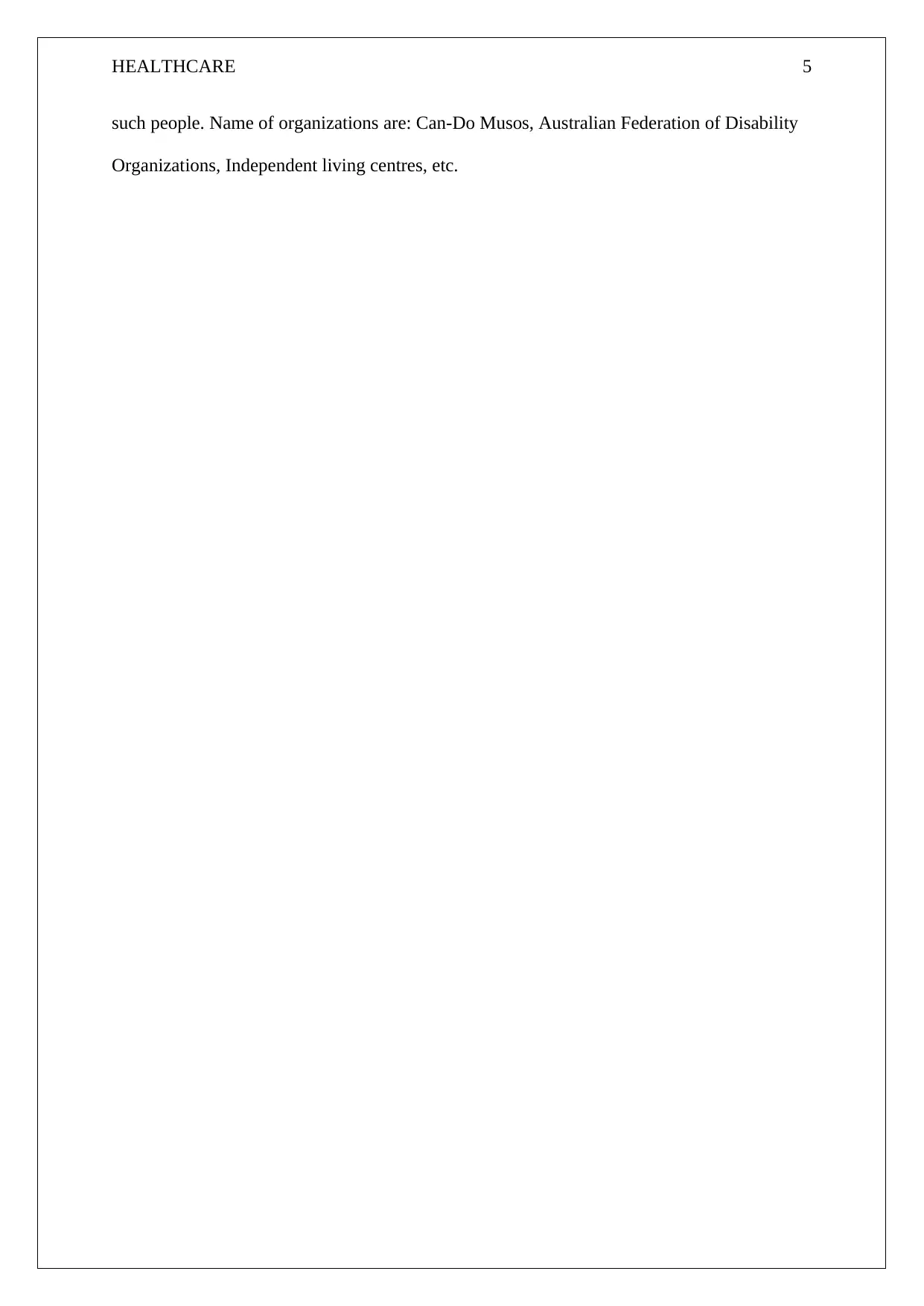
HEALTHCARE 5
such people. Name of organizations are: Can-Do Musos, Australian Federation of Disability
Organizations, Independent living centres, etc.
such people. Name of organizations are: Can-Do Musos, Australian Federation of Disability
Organizations, Independent living centres, etc.
⊘ This is a preview!⊘
Do you want full access?
Subscribe today to unlock all pages.

Trusted by 1+ million students worldwide
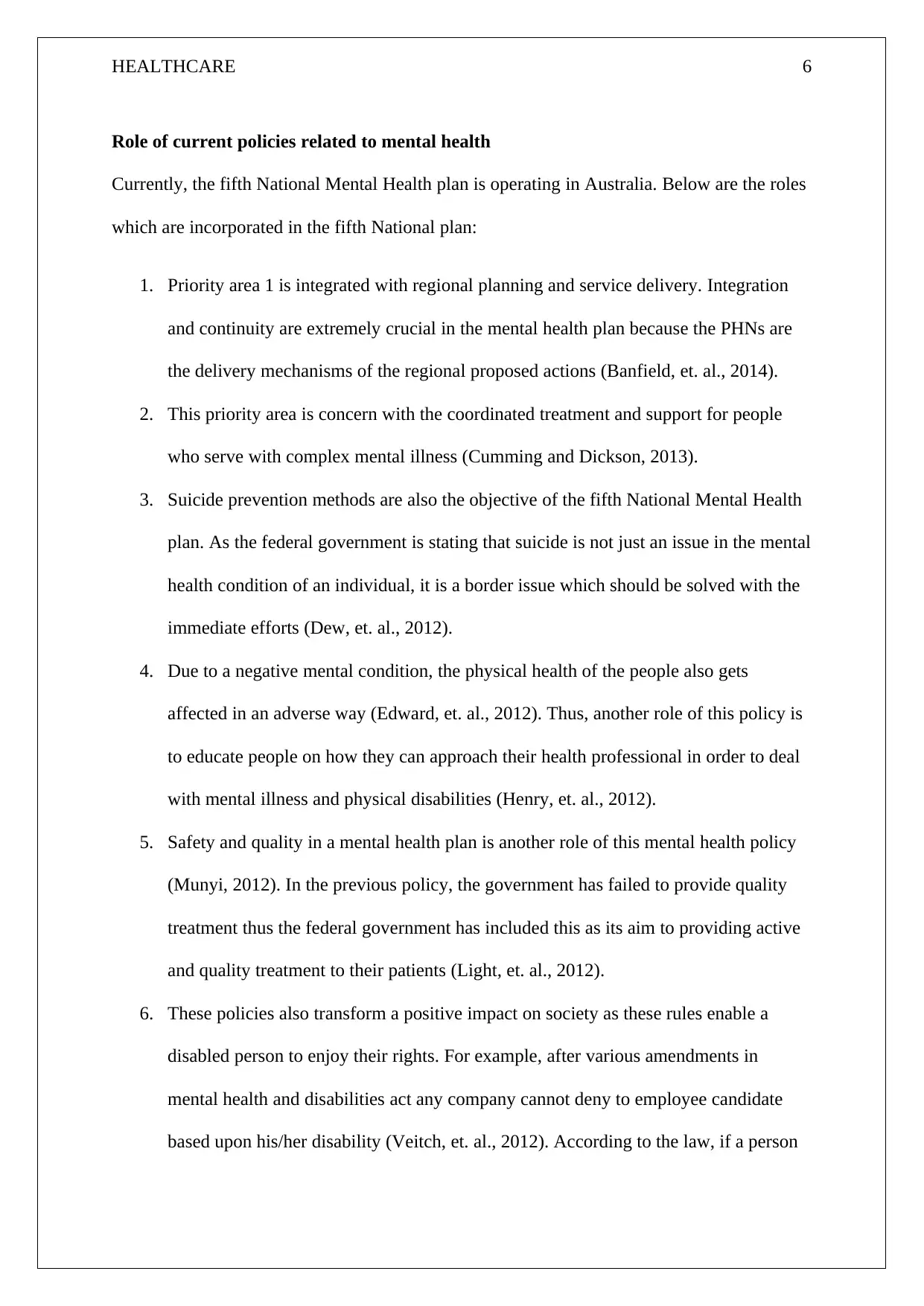
HEALTHCARE 6
Role of current policies related to mental health
Currently, the fifth National Mental Health plan is operating in Australia. Below are the roles
which are incorporated in the fifth National plan:
1. Priority area 1 is integrated with regional planning and service delivery. Integration
and continuity are extremely crucial in the mental health plan because the PHNs are
the delivery mechanisms of the regional proposed actions (Banfield, et. al., 2014).
2. This priority area is concern with the coordinated treatment and support for people
who serve with complex mental illness (Cumming and Dickson, 2013).
3. Suicide prevention methods are also the objective of the fifth National Mental Health
plan. As the federal government is stating that suicide is not just an issue in the mental
health condition of an individual, it is a border issue which should be solved with the
immediate efforts (Dew, et. al., 2012).
4. Due to a negative mental condition, the physical health of the people also gets
affected in an adverse way (Edward, et. al., 2012). Thus, another role of this policy is
to educate people on how they can approach their health professional in order to deal
with mental illness and physical disabilities (Henry, et. al., 2012).
5. Safety and quality in a mental health plan is another role of this mental health policy
(Munyi, 2012). In the previous policy, the government has failed to provide quality
treatment thus the federal government has included this as its aim to providing active
and quality treatment to their patients (Light, et. al., 2012).
6. These policies also transform a positive impact on society as these rules enable a
disabled person to enjoy their rights. For example, after various amendments in
mental health and disabilities act any company cannot deny to employee candidate
based upon his/her disability (Veitch, et. al., 2012). According to the law, if a person
Role of current policies related to mental health
Currently, the fifth National Mental Health plan is operating in Australia. Below are the roles
which are incorporated in the fifth National plan:
1. Priority area 1 is integrated with regional planning and service delivery. Integration
and continuity are extremely crucial in the mental health plan because the PHNs are
the delivery mechanisms of the regional proposed actions (Banfield, et. al., 2014).
2. This priority area is concern with the coordinated treatment and support for people
who serve with complex mental illness (Cumming and Dickson, 2013).
3. Suicide prevention methods are also the objective of the fifth National Mental Health
plan. As the federal government is stating that suicide is not just an issue in the mental
health condition of an individual, it is a border issue which should be solved with the
immediate efforts (Dew, et. al., 2012).
4. Due to a negative mental condition, the physical health of the people also gets
affected in an adverse way (Edward, et. al., 2012). Thus, another role of this policy is
to educate people on how they can approach their health professional in order to deal
with mental illness and physical disabilities (Henry, et. al., 2012).
5. Safety and quality in a mental health plan is another role of this mental health policy
(Munyi, 2012). In the previous policy, the government has failed to provide quality
treatment thus the federal government has included this as its aim to providing active
and quality treatment to their patients (Light, et. al., 2012).
6. These policies also transform a positive impact on society as these rules enable a
disabled person to enjoy their rights. For example, after various amendments in
mental health and disabilities act any company cannot deny to employee candidate
based upon his/her disability (Veitch, et. al., 2012). According to the law, if a person
Paraphrase This Document
Need a fresh take? Get an instant paraphrase of this document with our AI Paraphraser
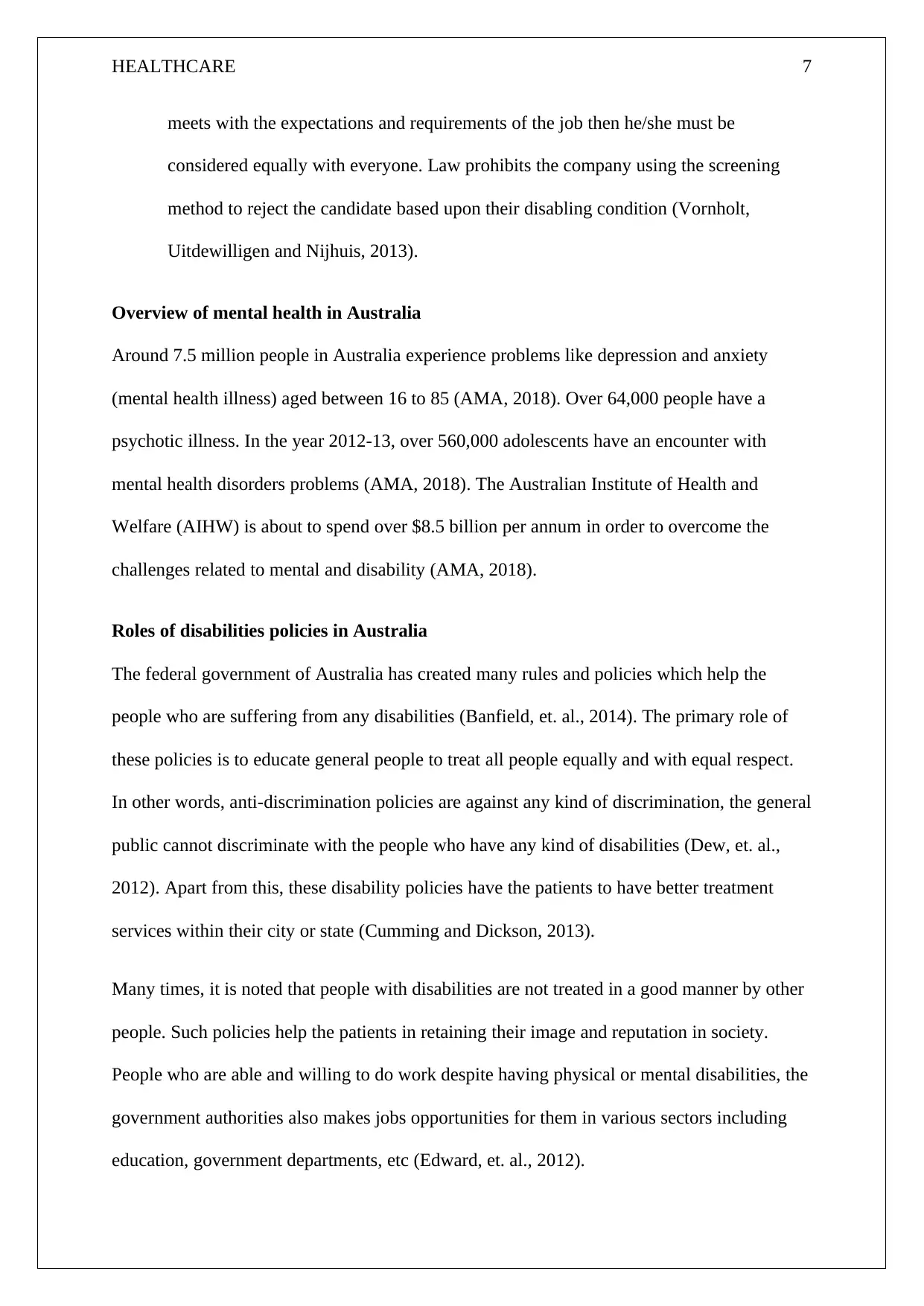
HEALTHCARE 7
meets with the expectations and requirements of the job then he/she must be
considered equally with everyone. Law prohibits the company using the screening
method to reject the candidate based upon their disabling condition (Vornholt,
Uitdewilligen and Nijhuis, 2013).
Overview of mental health in Australia
Around 7.5 million people in Australia experience problems like depression and anxiety
(mental health illness) aged between 16 to 85 (AMA, 2018). Over 64,000 people have a
psychotic illness. In the year 2012-13, over 560,000 adolescents have an encounter with
mental health disorders problems (AMA, 2018). The Australian Institute of Health and
Welfare (AIHW) is about to spend over $8.5 billion per annum in order to overcome the
challenges related to mental and disability (AMA, 2018).
Roles of disabilities policies in Australia
The federal government of Australia has created many rules and policies which help the
people who are suffering from any disabilities (Banfield, et. al., 2014). The primary role of
these policies is to educate general people to treat all people equally and with equal respect.
In other words, anti-discrimination policies are against any kind of discrimination, the general
public cannot discriminate with the people who have any kind of disabilities (Dew, et. al.,
2012). Apart from this, these disability policies have the patients to have better treatment
services within their city or state (Cumming and Dickson, 2013).
Many times, it is noted that people with disabilities are not treated in a good manner by other
people. Such policies help the patients in retaining their image and reputation in society.
People who are able and willing to do work despite having physical or mental disabilities, the
government authorities also makes jobs opportunities for them in various sectors including
education, government departments, etc (Edward, et. al., 2012).
meets with the expectations and requirements of the job then he/she must be
considered equally with everyone. Law prohibits the company using the screening
method to reject the candidate based upon their disabling condition (Vornholt,
Uitdewilligen and Nijhuis, 2013).
Overview of mental health in Australia
Around 7.5 million people in Australia experience problems like depression and anxiety
(mental health illness) aged between 16 to 85 (AMA, 2018). Over 64,000 people have a
psychotic illness. In the year 2012-13, over 560,000 adolescents have an encounter with
mental health disorders problems (AMA, 2018). The Australian Institute of Health and
Welfare (AIHW) is about to spend over $8.5 billion per annum in order to overcome the
challenges related to mental and disability (AMA, 2018).
Roles of disabilities policies in Australia
The federal government of Australia has created many rules and policies which help the
people who are suffering from any disabilities (Banfield, et. al., 2014). The primary role of
these policies is to educate general people to treat all people equally and with equal respect.
In other words, anti-discrimination policies are against any kind of discrimination, the general
public cannot discriminate with the people who have any kind of disabilities (Dew, et. al.,
2012). Apart from this, these disability policies have the patients to have better treatment
services within their city or state (Cumming and Dickson, 2013).
Many times, it is noted that people with disabilities are not treated in a good manner by other
people. Such policies help the patients in retaining their image and reputation in society.
People who are able and willing to do work despite having physical or mental disabilities, the
government authorities also makes jobs opportunities for them in various sectors including
education, government departments, etc (Edward, et. al., 2012).
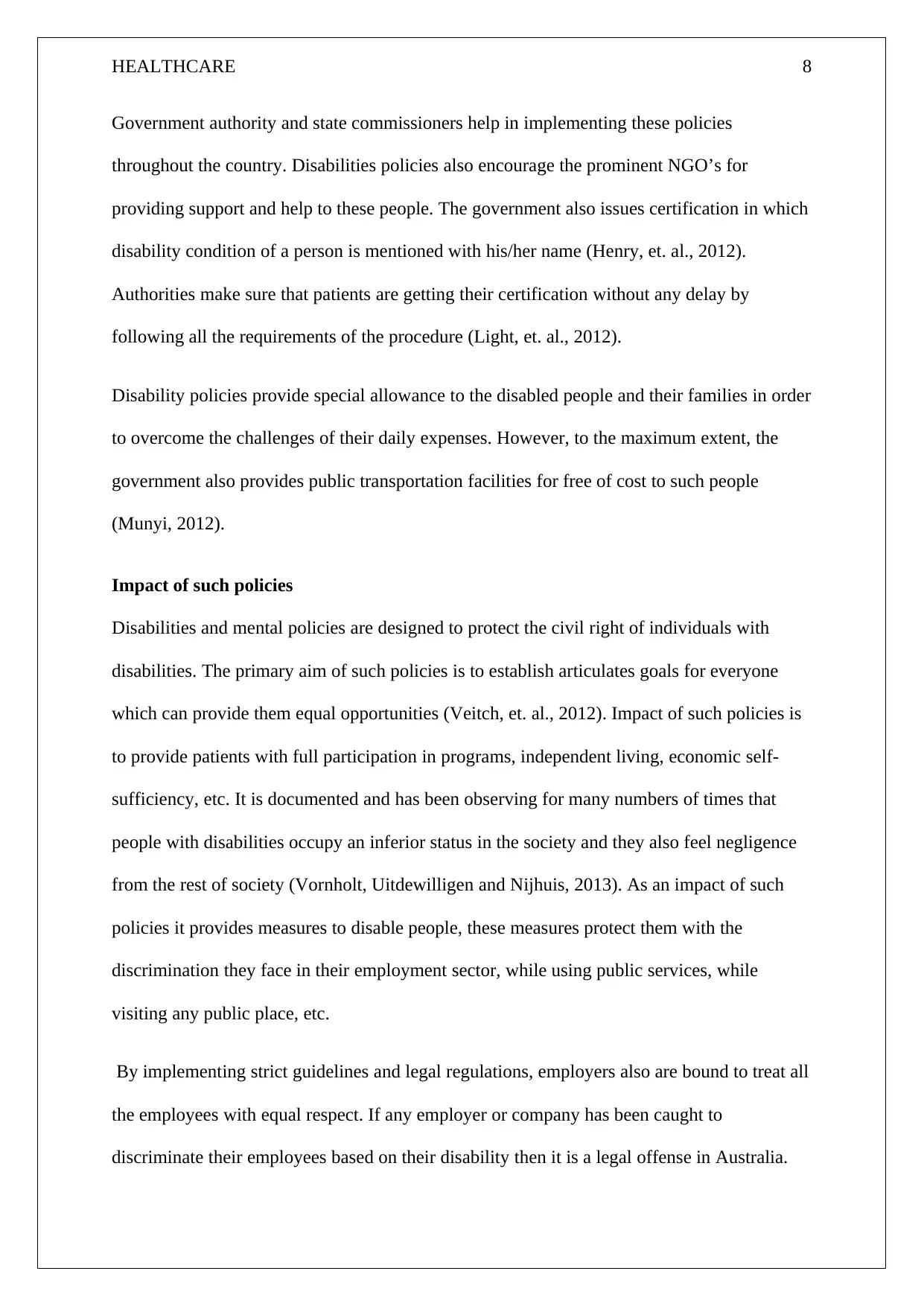
HEALTHCARE 8
Government authority and state commissioners help in implementing these policies
throughout the country. Disabilities policies also encourage the prominent NGO’s for
providing support and help to these people. The government also issues certification in which
disability condition of a person is mentioned with his/her name (Henry, et. al., 2012).
Authorities make sure that patients are getting their certification without any delay by
following all the requirements of the procedure (Light, et. al., 2012).
Disability policies provide special allowance to the disabled people and their families in order
to overcome the challenges of their daily expenses. However, to the maximum extent, the
government also provides public transportation facilities for free of cost to such people
(Munyi, 2012).
Impact of such policies
Disabilities and mental policies are designed to protect the civil right of individuals with
disabilities. The primary aim of such policies is to establish articulates goals for everyone
which can provide them equal opportunities (Veitch, et. al., 2012). Impact of such policies is
to provide patients with full participation in programs, independent living, economic self-
sufficiency, etc. It is documented and has been observing for many numbers of times that
people with disabilities occupy an inferior status in the society and they also feel negligence
from the rest of society (Vornholt, Uitdewilligen and Nijhuis, 2013). As an impact of such
policies it provides measures to disable people, these measures protect them with the
discrimination they face in their employment sector, while using public services, while
visiting any public place, etc.
By implementing strict guidelines and legal regulations, employers also are bound to treat all
the employees with equal respect. If any employer or company has been caught to
discriminate their employees based on their disability then it is a legal offense in Australia.
Government authority and state commissioners help in implementing these policies
throughout the country. Disabilities policies also encourage the prominent NGO’s for
providing support and help to these people. The government also issues certification in which
disability condition of a person is mentioned with his/her name (Henry, et. al., 2012).
Authorities make sure that patients are getting their certification without any delay by
following all the requirements of the procedure (Light, et. al., 2012).
Disability policies provide special allowance to the disabled people and their families in order
to overcome the challenges of their daily expenses. However, to the maximum extent, the
government also provides public transportation facilities for free of cost to such people
(Munyi, 2012).
Impact of such policies
Disabilities and mental policies are designed to protect the civil right of individuals with
disabilities. The primary aim of such policies is to establish articulates goals for everyone
which can provide them equal opportunities (Veitch, et. al., 2012). Impact of such policies is
to provide patients with full participation in programs, independent living, economic self-
sufficiency, etc. It is documented and has been observing for many numbers of times that
people with disabilities occupy an inferior status in the society and they also feel negligence
from the rest of society (Vornholt, Uitdewilligen and Nijhuis, 2013). As an impact of such
policies it provides measures to disable people, these measures protect them with the
discrimination they face in their employment sector, while using public services, while
visiting any public place, etc.
By implementing strict guidelines and legal regulations, employers also are bound to treat all
the employees with equal respect. If any employer or company has been caught to
discriminate their employees based on their disability then it is a legal offense in Australia.
⊘ This is a preview!⊘
Do you want full access?
Subscribe today to unlock all pages.

Trusted by 1+ million students worldwide
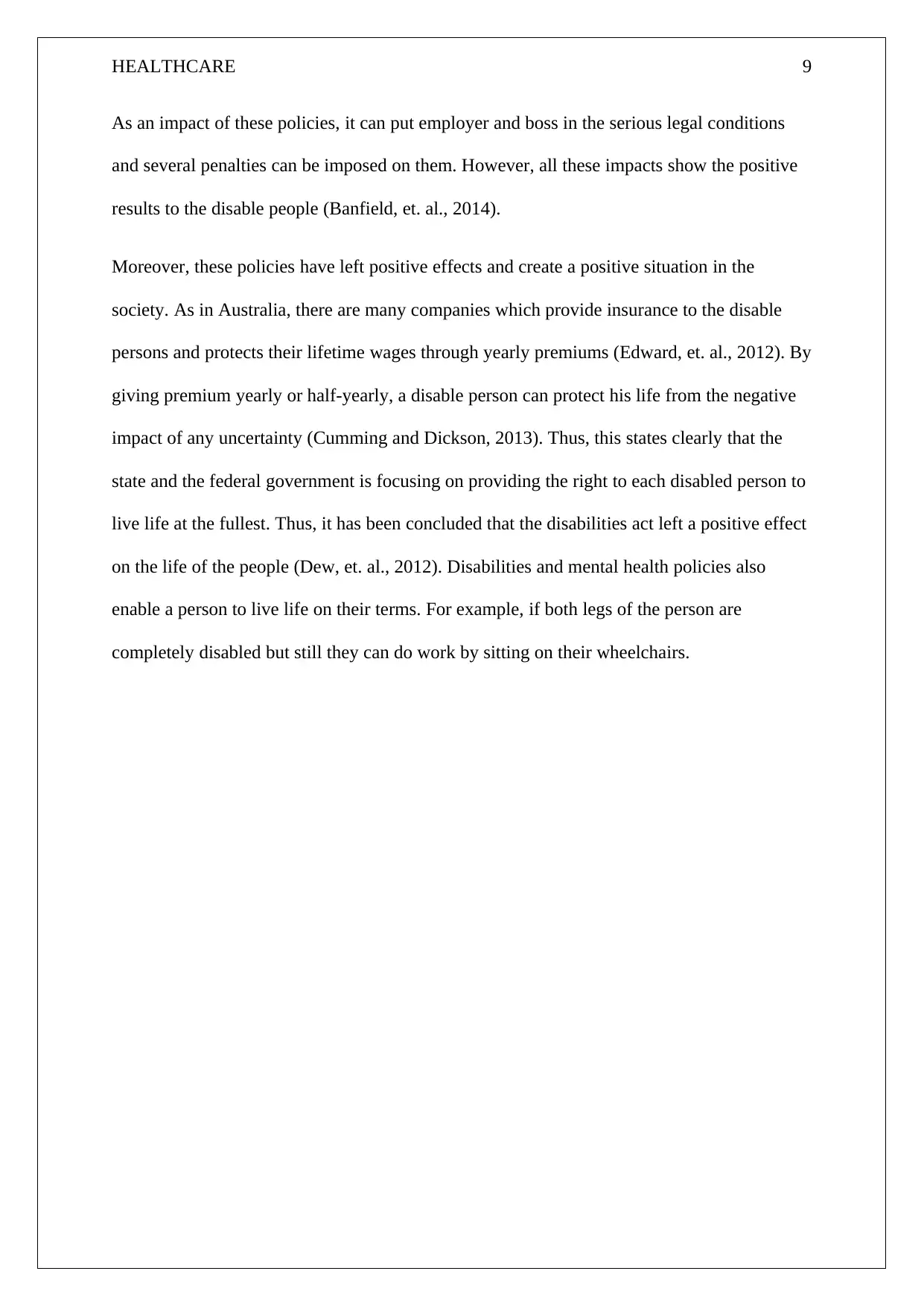
HEALTHCARE 9
As an impact of these policies, it can put employer and boss in the serious legal conditions
and several penalties can be imposed on them. However, all these impacts show the positive
results to the disable people (Banfield, et. al., 2014).
Moreover, these policies have left positive effects and create a positive situation in the
society. As in Australia, there are many companies which provide insurance to the disable
persons and protects their lifetime wages through yearly premiums (Edward, et. al., 2012). By
giving premium yearly or half-yearly, a disable person can protect his life from the negative
impact of any uncertainty (Cumming and Dickson, 2013). Thus, this states clearly that the
state and the federal government is focusing on providing the right to each disabled person to
live life at the fullest. Thus, it has been concluded that the disabilities act left a positive effect
on the life of the people (Dew, et. al., 2012). Disabilities and mental health policies also
enable a person to live life on their terms. For example, if both legs of the person are
completely disabled but still they can do work by sitting on their wheelchairs.
As an impact of these policies, it can put employer and boss in the serious legal conditions
and several penalties can be imposed on them. However, all these impacts show the positive
results to the disable people (Banfield, et. al., 2014).
Moreover, these policies have left positive effects and create a positive situation in the
society. As in Australia, there are many companies which provide insurance to the disable
persons and protects their lifetime wages through yearly premiums (Edward, et. al., 2012). By
giving premium yearly or half-yearly, a disable person can protect his life from the negative
impact of any uncertainty (Cumming and Dickson, 2013). Thus, this states clearly that the
state and the federal government is focusing on providing the right to each disabled person to
live life at the fullest. Thus, it has been concluded that the disabilities act left a positive effect
on the life of the people (Dew, et. al., 2012). Disabilities and mental health policies also
enable a person to live life on their terms. For example, if both legs of the person are
completely disabled but still they can do work by sitting on their wheelchairs.
Paraphrase This Document
Need a fresh take? Get an instant paraphrase of this document with our AI Paraphraser
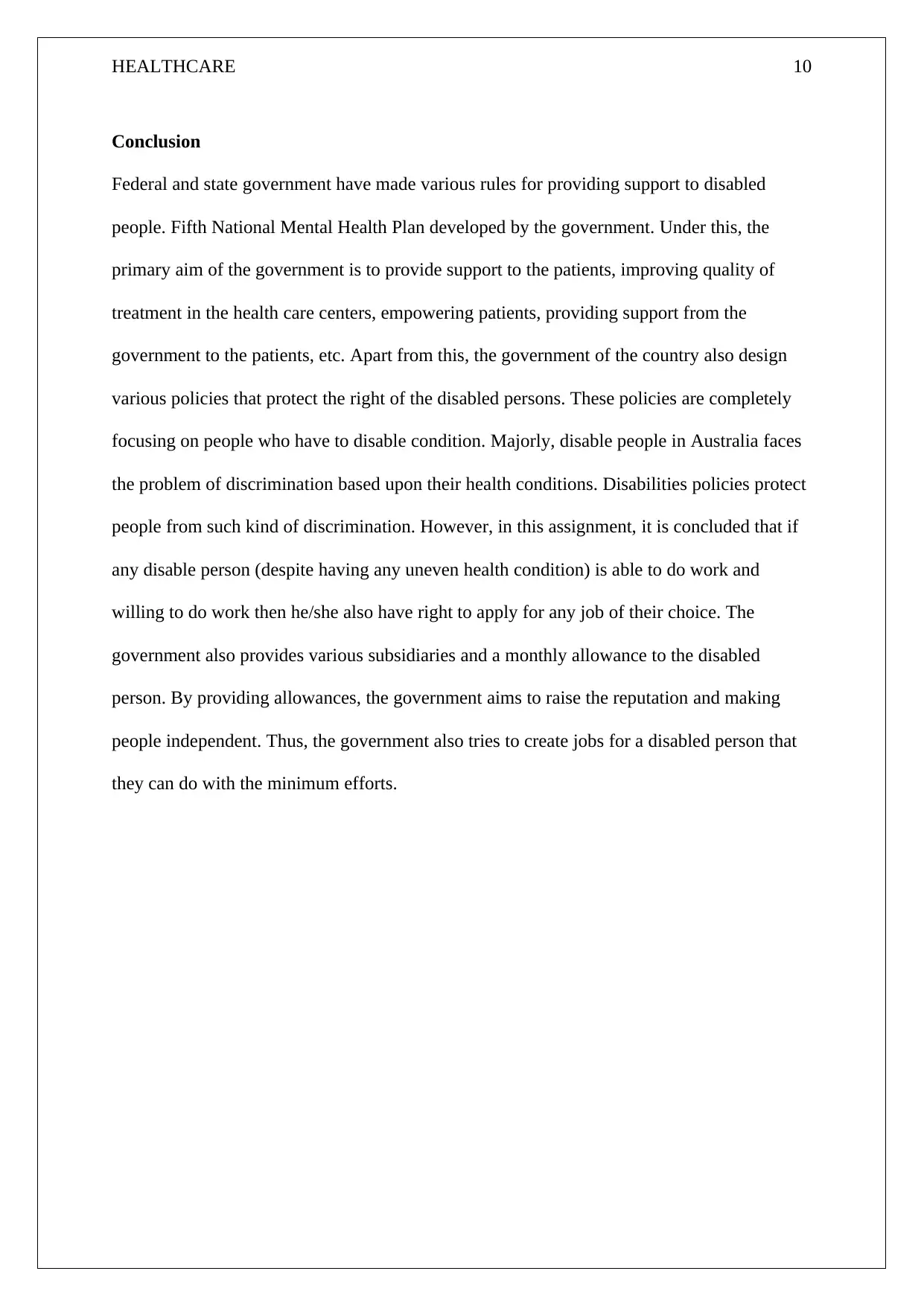
HEALTHCARE 10
Conclusion
Federal and state government have made various rules for providing support to disabled
people. Fifth National Mental Health Plan developed by the government. Under this, the
primary aim of the government is to provide support to the patients, improving quality of
treatment in the health care centers, empowering patients, providing support from the
government to the patients, etc. Apart from this, the government of the country also design
various policies that protect the right of the disabled persons. These policies are completely
focusing on people who have to disable condition. Majorly, disable people in Australia faces
the problem of discrimination based upon their health conditions. Disabilities policies protect
people from such kind of discrimination. However, in this assignment, it is concluded that if
any disable person (despite having any uneven health condition) is able to do work and
willing to do work then he/she also have right to apply for any job of their choice. The
government also provides various subsidiaries and a monthly allowance to the disabled
person. By providing allowances, the government aims to raise the reputation and making
people independent. Thus, the government also tries to create jobs for a disabled person that
they can do with the minimum efforts.
Conclusion
Federal and state government have made various rules for providing support to disabled
people. Fifth National Mental Health Plan developed by the government. Under this, the
primary aim of the government is to provide support to the patients, improving quality of
treatment in the health care centers, empowering patients, providing support from the
government to the patients, etc. Apart from this, the government of the country also design
various policies that protect the right of the disabled persons. These policies are completely
focusing on people who have to disable condition. Majorly, disable people in Australia faces
the problem of discrimination based upon their health conditions. Disabilities policies protect
people from such kind of discrimination. However, in this assignment, it is concluded that if
any disable person (despite having any uneven health condition) is able to do work and
willing to do work then he/she also have right to apply for any job of their choice. The
government also provides various subsidiaries and a monthly allowance to the disabled
person. By providing allowances, the government aims to raise the reputation and making
people independent. Thus, the government also tries to create jobs for a disabled person that
they can do with the minimum efforts.
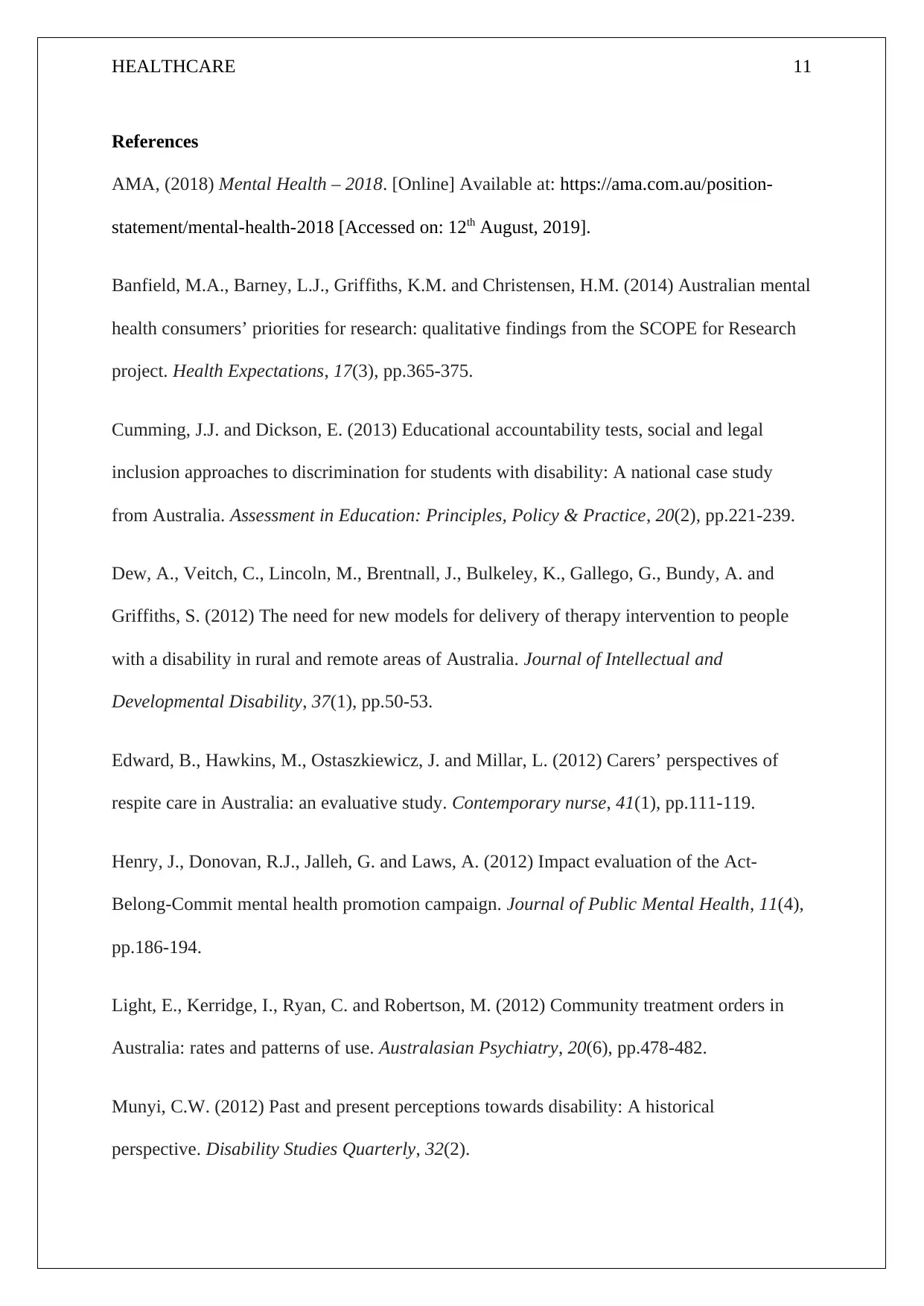
HEALTHCARE 11
References
AMA, (2018) Mental Health – 2018. [Online] Available at: https://ama.com.au/position-
statement/mental-health-2018 [Accessed on: 12th August, 2019].
Banfield, M.A., Barney, L.J., Griffiths, K.M. and Christensen, H.M. (2014) Australian mental
health consumers’ priorities for research: qualitative findings from the SCOPE for Research
project. Health Expectations, 17(3), pp.365-375.
Cumming, J.J. and Dickson, E. (2013) Educational accountability tests, social and legal
inclusion approaches to discrimination for students with disability: A national case study
from Australia. Assessment in Education: Principles, Policy & Practice, 20(2), pp.221-239.
Dew, A., Veitch, C., Lincoln, M., Brentnall, J., Bulkeley, K., Gallego, G., Bundy, A. and
Griffiths, S. (2012) The need for new models for delivery of therapy intervention to people
with a disability in rural and remote areas of Australia. Journal of Intellectual and
Developmental Disability, 37(1), pp.50-53.
Edward, B., Hawkins, M., Ostaszkiewicz, J. and Millar, L. (2012) Carers’ perspectives of
respite care in Australia: an evaluative study. Contemporary nurse, 41(1), pp.111-119.
Henry, J., Donovan, R.J., Jalleh, G. and Laws, A. (2012) Impact evaluation of the Act-
Belong-Commit mental health promotion campaign. Journal of Public Mental Health, 11(4),
pp.186-194.
Light, E., Kerridge, I., Ryan, C. and Robertson, M. (2012) Community treatment orders in
Australia: rates and patterns of use. Australasian Psychiatry, 20(6), pp.478-482.
Munyi, C.W. (2012) Past and present perceptions towards disability: A historical
perspective. Disability Studies Quarterly, 32(2).
References
AMA, (2018) Mental Health – 2018. [Online] Available at: https://ama.com.au/position-
statement/mental-health-2018 [Accessed on: 12th August, 2019].
Banfield, M.A., Barney, L.J., Griffiths, K.M. and Christensen, H.M. (2014) Australian mental
health consumers’ priorities for research: qualitative findings from the SCOPE for Research
project. Health Expectations, 17(3), pp.365-375.
Cumming, J.J. and Dickson, E. (2013) Educational accountability tests, social and legal
inclusion approaches to discrimination for students with disability: A national case study
from Australia. Assessment in Education: Principles, Policy & Practice, 20(2), pp.221-239.
Dew, A., Veitch, C., Lincoln, M., Brentnall, J., Bulkeley, K., Gallego, G., Bundy, A. and
Griffiths, S. (2012) The need for new models for delivery of therapy intervention to people
with a disability in rural and remote areas of Australia. Journal of Intellectual and
Developmental Disability, 37(1), pp.50-53.
Edward, B., Hawkins, M., Ostaszkiewicz, J. and Millar, L. (2012) Carers’ perspectives of
respite care in Australia: an evaluative study. Contemporary nurse, 41(1), pp.111-119.
Henry, J., Donovan, R.J., Jalleh, G. and Laws, A. (2012) Impact evaluation of the Act-
Belong-Commit mental health promotion campaign. Journal of Public Mental Health, 11(4),
pp.186-194.
Light, E., Kerridge, I., Ryan, C. and Robertson, M. (2012) Community treatment orders in
Australia: rates and patterns of use. Australasian Psychiatry, 20(6), pp.478-482.
Munyi, C.W. (2012) Past and present perceptions towards disability: A historical
perspective. Disability Studies Quarterly, 32(2).
⊘ This is a preview!⊘
Do you want full access?
Subscribe today to unlock all pages.

Trusted by 1+ million students worldwide
1 out of 13
Related Documents
Your All-in-One AI-Powered Toolkit for Academic Success.
+13062052269
info@desklib.com
Available 24*7 on WhatsApp / Email
![[object Object]](/_next/static/media/star-bottom.7253800d.svg)
Unlock your academic potential
Copyright © 2020–2025 A2Z Services. All Rights Reserved. Developed and managed by ZUCOL.





